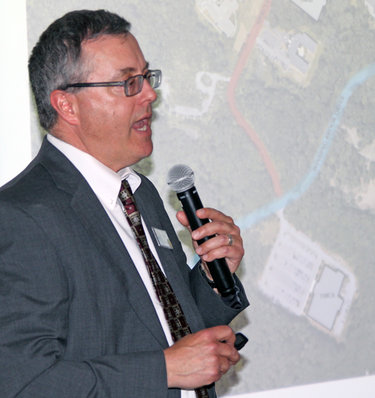Referendum for $7M: Library update would increase children and adult space
The Enterprise — Elizabeth Floyd Mair
Over the 27 years since the library building went up, the population of Guilderland has risen 20 percent while the number of library visits has increased 185 percent, Timothy Wiles, the library’s director, told the half-dozen or so people gathered at the library on May 2 for an informational session on a proposed project that would expand and update the building.
GUILDERLAND — Voters will decide on May 21 whether to spend $7 million for an $8.4 million library expansion project.
“This is the only place in our town where you can come for free,” Timothy Wiles, director of the Guilderland Public Library, told a dozen or so residents who had gathered at the library on the evening of May 2 for an informational meeting about the proposed capital project.
The project would increase the size of the library by about a quarter to meet current needs, Wiles says, and should last for another quarter of a century. Project costs total $8,353,698 but this will be offset from a capital account of $1.4 million.
The cost to taxpayers will depend on the length of the bond. With a 20-year bond at $12.30 per $1,000 of assessed value, the annual cost for a $300,000 home would be $36.90.
If voters pass the project, Wiles said, construction work will not interfere with ongoing library activities. “The library would be open most of the time,” he said.
No new employees would be hired as a result of the project, Wiles said. He told the group on May 2, “We will add zero positions as a result of adding this space.”
The project was developed based on a survey of over 2,000 library patrons. Ten percent wanted “a robust and imaginative children’s room.”
The entire added space is for a new children’s room, which would free up space for other planned improvements. Wiles estimated that the current children’s room takes up about one-third of the library space, not counting restrooms, hallways, or lobbies.
The project would increase adult materials in the library by 10.7 percent and would allow the larger collection to be spread over more space by moving the children’s and teens’ areas. Teens would have a dedicated room for the first time, from within existing space.
Library seating would increase by 57 percent, including a number of reading niches. Meeting and study space would grow by 28 percent.
The plan allows for flexible use of spaces, Wiles said. If an event needed to seat as many as 350 people, space could be created in the adult collection area, since the lower bookshelves on locked wheels could be moved to make room.
The parking lot would be reconfigured and expanded and a pedestrian walkway with benches would allow people with families and people with disabilities to enter the library more safely. A sprinkler system would make the building safer.
And an outsourced café near the library’s entrance would encourage people to stay longer and create additional revenue for the library. The café would be approximately where the Tawasentha Room is now, to the left of the front entrance, when facing the library. The Tawasentha Room is where the board meets and the local-history collection is housed.
The proposals contained in the referendum would make it possible to use the library — comfortably — at the level of its current use, Wiles said.
Wiles showed a chart that described how much library use has grown over the 27 years since the building went up, in 1992:
— The town’s population has gone up almost 20 percent, from 30,219 to 36,171;
— Registered borrowers have increased 25.39 percent, from 13,046 to 16,358;
— Materials checked out have risen 286.31 percent, from 132,815 to 513,080;
— Library visits have increased 185 percent, from 76,544 to 217,922;
— Reference questions answered have gone up 497.48 percent, from 6,322 to 37,773; and
— Programs have gone up from “very little” to 775.
Patrons surveyed
In 2012, a $13 million project, which would have nearly doubled the size of the library, was defeated at the polls. The library trustees did not simply revisit the defeated capital project and cut things from it, Wiles.
Instead, he said, the library spent about six months surveying library users — a total of 2,108 people — to find out what they want and what they would be willing to pay for; the library then worked from those results to create the current project, he said.
Library users’ number-one priority was safety and accessibility, Wiles said in his presentation, with 24 percent citing this. Next was a café-bookstore, with 23 percent of those surveyed calling this their highest priority.
Next were traditional programs (story times, book clubs, movies, local history, etcetera, Wiles explained) and non-traditional programs (on parenting, senior issues, and other timely topics), each with 14 percent; and, at 10 percent each, a robust children’s room and indoor reading niches.
“We surveyed the community, and we’re not adding anything that they didn’t tell us they wanted,” Wiles said.
The goal of the renovation, Wiles said, is to give the library enough space to meet current demand. He anticipates that the improvements would serve for another quarter-century.
“Starbooks”
Wiles said that the Guilderland library has allowed food and drink for a long time. “But if you want food and drink, you have to bring it, or get it from the vending machines, or go out and come back,” he said. “But what we find is that they don’t come back.”
A café-bookstore would bring a number of improvements, Wiles said. It would allow the library to create a more attractive lobby by removing the used-book sale shelves and placing them around the inside of a dedicated café room.
The café would encourage patrons to stay longer, since they would no longer have to leave if they or their children became hungry or thirsty; this is important since the library wants to be a “third space,” or a place other than work or home where people can feel comfortable spending time.
The café would bring in revenue and would help a local organization. Wiles said that the library would not run the café but would contract the work out to a local group. One example of a possible model is Puzzles Bakery & Café in Schenectady, which hires people with developmental disabilities. Another possibility, Wiles said, would be to contract the work to Schenectady County Community College or another college to create an entirely student-run café.
Wiles said the library would view the rental to an outside business, school, or other agency as a revenue generator. If the café were to fail to thrive over time, he said, the space could become a lounge. Vending machines could be placed there, and it could become additional seating.
Wiles quipped that the library staff refers to the proposed café, for the time being (“until we get sued”), as “Starbooks.”
Getting the word out
Wiles said this week that he and architect Paul Mays have held several informational sessions at the library to date, with a total of about 70 people attending so far. Additional sessions are scheduled for Thursday, May 9, at 1 p.m. and Tuesday, May 14, at 10 a.m.
In addition, Wiles said, he has gone to speak to 15 or 20 community groups, including the town’s Republican committee, the Guilderland seniors’ luncheon, and the parent-teacher associations of six of the seven schools in the Guilderland district. Bryan Best, president of the library’s board of trustees,visited the seventh, Wiles said.
In addition, Wiles will hold an all-day drop-in session at the library on May 20 from 10 a.m. to 6 p.m. called “Ask Me Anything.”
“Nothing is ever wasted,” Wiles said. Even if the referendum were to be defeated at the polls, he said, “Through this referendum, we’ve built a lot of connections to the people we serve.”



